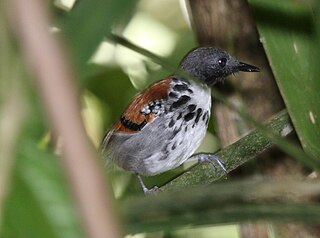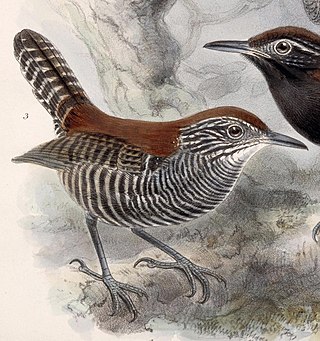
The rock wren is a small songbird of the wren family native to western North America, Mexico and Central America. It is the only species in the genus Salpinctes.

The rufous-breasted wren is a small songbird of the family Troglodytidae. It is found in Colombia, Costa Rica, Panama, Trinidad and Tobago, and Venezuela.

The collared plover is a small shorebird in the plover family, Charadriidae. It lives along coasts and riverbanks of the tropical to temperate Americas, from central Mexico south to Chile and Argentina.

The black-cheeked warbler is a New World warbler, resident breeding bird endemic to the Talamancan montane forests of Costa Rica and western Panama.

The silver-throated tanager is a species of passerine bird in the tanager family Thraupidae. It is found in Costa Rica, Panama, Colombia, Ecuador, and northeastern Peru. It inhabits mossy forests, montane evergreen forests, tropical lowland evergreen forests and forest edges, along with tall secondary forests and disturbed habitat with remnant trees and forest. It is 13 centimetres (5.1 in) long and weighs 22 grams (0.78 oz) on average, and shows slight sexual dimorphism, with duller female plumage. Adult males are mainly bright yellow, with a silvery-white throat bordered above with a black stripe on the cheeks, black streaking on the back, and green edges to the wings and tail. Juveniles are duller and greener.

The white-whiskered puffbird, also called the white-whiskered soft-wing or brown puffbird, is a near-passerine bird in the family Bucconidae, the puffbirds, nunlets, and nunbirds. It is found from southeastern Mexico through Central America, Colombia, and Ecuador into Peru.

The white-breasted wood wren is a small songbird of the wren family. It is a resident breeding species from central Mexico to northeastern Peru and Suriname.

The rufous-and-white wren is a small songbird of the wren family. It is a resident breeding species from southwesternmost Mexico to northern Colombia and northwestern Venezuela. It was formerly placed in the genus Thryothorus.

The banded wren is a small songbird of the wren family. It is a resident breeding species from central Mexico to Costa Rica. It was formerly placed in the genus Thryothorus.

The rufous-backed wren is a songbird of the family Troglodytidae. It is a resident breeding species from southwest Mexico to northwestern Costa Rica.

The dot-winged antwren is a passerine bird in the antbird family. In the past it was sometimes known as the velvety antwren, and some of its more distinctive subspecies have their own infrequently used English names. It is a resident in tropical Central and South America from southeastern Mexico south to western Ecuador, northern Bolivia, central Brazil and the Guianas. It is the only member of the genus Microrhopias.

The chestnut-backed antbird is a passerine bird in the antbird family. It is found in humid forests in Central and South America (Chocó-Magdalena), ranging from eastern Nicaragua to western Ecuador. It mainly occurs in lowlands up to an altitude of 900 metres (3,000 ft) m, but locally it occurs higher.

The black-striped sparrow is a passerine bird found from eastern Honduras to western Ecuador, northern Brazil, and Venezuela.

The white-headed wren is a species of bird in the family Troglodytidae. It is found in Colombia and Panama.

The giant wren is a species of bird in the family Troglodytidae. It is found in Mexico and Guatemala.

The song wren is a species of bird in the family Troglodytidae. It is found in Colombia, Costa Rica, Ecuador, Honduras, Nicaragua, and Panama.

The spotted antbird is a species of bird in the family Thamnophilidae. In southern Central America, it is found in Honduras, Nicaragua, Costa Rica and Panama; also Colombia and Ecuador of northwestern South America. Its natural habitat is subtropical or tropical moist lowland forests.

The southern nightingale-wren, also known as the scaly-breasted wren, is a species of bird in the family Troglodytidae. It is found in Bolivia, Brazil, Colombia, Costa Rica, Ecuador, Panama, Peru, and Venezuela.

The bay wren is a species of bird in the family Troglodytidae. It is native to southern Central America and northwestern South America.

The riverside wren is a species of bird in the family Troglodytidae. It is found in Costa Rica and Panama.






















